Analysts predict that the foodservice industry will amplify its use of drones in 2024. Now that technology and logistics have advanced to a more functional level, efforts to revolutionize food delivery is underway. In this article, we look at the possible ways drones may make their mark in the foodservice delivery in 2024, as well as factors that both hinder and aid in their success.
The Next Frontier in Foodservice Delivery
There are several reasons why analysts are predicting a significant rise in drone food delivery in 2024.
Competition Ushers Technology

Drone technology is maturing and becoming more commercially viable. With advancements in battery life, navigation systems, and obstacle avoidance, drones now have more potential to be a reliable and feasible delivery option. Additionally, regulatory hurdles are gradually being addressed, with countries like the US, UK, and Australia launching pilot programs and establishing guidelines for drone operations.
Major players in the food delivery industry like Amazon, Domino’s, and Uber Eats are actively investing in drone technology. Healthy competition amongst foodservice giants is also driving innovation and accelerating the development of reliable and efficient drone delivery systems.
For major players in the foodservice industry the hope is that drones will provide more efficient services to customers while saving companies money on delivery cost. Unlike cars and trucks, drones can navigate traffic congestion, reach remote areas faster, and operate 24/7 without the company paying overtime or benefits like health insurance.
Customers Want Faster, Convenient, & Eco-Friendly Delivery Options

There’s a growing interest in faster, convenient, eco-friendly delivery options. Drones offer the potential for quicker food delivery, even within urban areas, making them an attractive option for busy consumers.
Drones have the potential to deliver food to areas with limited access, such as rural communities, mountainous regions, or islands. If successful and cost effective, analysts have remarked that new markets will open for food delivery services to communities who previously faced logistical challenges.
There may also be environmental benefits. Compared to traditional delivery vehicles, electric drones produce fewer emissions, potentially contributing to a greener delivery ecosystem in the future. The growing consumer demand for sustainable solutions could incentivize companies to adopt drone technology as well.
Sky’s the Limit for Drones in Iceland & China

Successful food delivery programs featuring drones have popped up around the globe in the last several years. For instance, Aha in Iceland delivers restaurant orders to the citizens of Reykjavik through a partnership with Flytrex drones. Flytrex also offers drone delivery services in several US cities including Granbury, Texas and Durham, North Carolina.
In China, companies like Meituan, are already redefining food delivery with drones. In 2022, Meituan made more than 100,000 deliveries in Shenzhen, China’s third most populated city, navigating obstacles such as skyscrapers.
Anticipating the Challenges Ahead

Of course, challenges remain. The Federal Aviation Administration (FAA) is still developing regulations for drone use. Integrating drones into existing delivery infrastructure, ensuring public safety and privacy, and navigating complex regulations are hurdles that the FAA needs to sort out.
The Buzz About Drones

Food delivery via drones is an exciting technology with the potential to change the way we live. While the pace of adoption may vary depending on the specific region and market factors, analysts predict the overall trend points towards a growing role for drones in the food delivery industry in the coming year. Do you agree with foodservice and technology analysts’ outlook on drones for 2024? Let us know in the comment section!



